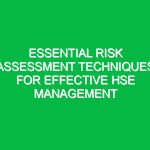Introduction
In the realm of Health, Safety, and Environment (HSE) management, the concept of a risk assessment table is paramount. This structured tool enables organizations to systematically identify, evaluate, and prioritize risks associated with their operations. By visualizing potential Hazards, the risk assessment table serves as a cornerstone for fostering a safe and compliant working environment.
Understanding the intricacies of risk assessment is essential for any organization aiming to enhance its HSE practices. A well-formulated risk assessment table can not only safeguard employees and the environment but also streamline compliance with legal requirements. This article delves into the components of a risk assessment table, its significance in HSE management, and practical insights to optimize its usage.
The Structure of a Risk Assessment Table
A risk assessment table typically comprises several key components that collectively provide a comprehensive overview of potential risks. Below is a refined structure relevant to the HSE context:
| Risk Description | Likelihood (1-5) | Severity (1-5) | Risk Level (Likelihood x Severity) | Control Measures | Responsible Person | Review Date |
|---|---|---|---|---|---|---|
| Example: Chemical Spill | 4 | 5 | 20 | Install spill kits, training on handling chemicals | HSE Manager | 12/31/2023 |
| Example: Electrical Hazard | 3 | 4 | 12 | Regular inspections, employee Training | Maintenance Supervisor | 12/31/2023 |
In this table, the various columns serve distinct purposes. The “Risk Description” column outlines the specific hazard, while “Likelihood” and “Severity” are rated on a scale from 1 to 5, allowing for a quantitative assessment of risks. The “Risk Level” is calculated by multiplying the likelihood by the severity, providing an immediate visual cue for prioritization.
The “Control Measures” column lists the strategies employed to mitigate each risk, while the “Responsible Person” indicates who is accountable for implementation. Finally, the “Review Date” ensures that risks are regularly reassessed and managed effectively.
Key Concepts in Risk Assessment
Understanding the core concepts surrounding risk assessment is vital.
1. Identification of Hazards
The first step is identifying potential hazards within the workplace. This can include physical hazards like machinery, chemical hazards like toxic substances, and ergonomic hazards from repetitive tasks. Engaging employees in hazard identification can provide insights that may not be immediately evident to management.
2. Evaluation of Risks
Once hazards are identified, evaluating the associated risks involves determining both the likelihood of occurrence and the potential severity of the consequences. This evaluation is crucial as it helps prioritize which risks require immediate attention.
3. Implementation of Control Measures
Control measures are the strategies and practices put in place to mitigate identified risks. These can range from engineering controls, such as installing Safety guards on machines, to administrative controls like training programs and Safety protocols.
4. Monitoring and Review
Effective HSE management requires continuous monitoring and periodic review of the risk assessment table. This ensures that Control Measures are functioning as intended and allows for adjustments based on new information or changes in operational practices.
Benefits of a Risk Assessment Table
Utilizing a risk assessment table offers numerous Benefits:
- Enhanced Safety: By systematically identifying and mitigating risks, organizations can create a safer working environment, reducing the likelihood of accidents and injuries.
- Regulatory Compliance: Many industries must adhere to strict Regulations regarding health and safety. A well-maintained risk assessment table helps ensure compliance with these legal requirements.
- Improved Resource Allocation: The prioritization of risks allows organizations to allocate resources more effectively, directing attention and funding to the most critical areas.
- Increased Awareness: Involving employees in the risk assessment process fosters a culture of safety awareness and encourages proactive participation in HSE initiatives.
Best Practices for Creating an Effective Risk Assessment Table
While a risk assessment table is a powerful tool, its effectiveness hinges on how well it is constructed and utilized. Here are some Best Practices to consider:
1. Involve Stakeholders
Engage employees from different departments in the risk assessment process. Their firsthand experience is invaluable for identifying hazards and evaluating risks accurately.
2. Use Clear and Concise Language
Ensure that the language used in the risk assessment table is straightforward and accessible. Avoid jargon unless it is defined clearly, as this promotes better understanding across all levels of the organization.
3. Regularly Update the Table
Set a schedule for reviewing and updating the risk assessment table. Changes in operations, new equipment, or updated regulations can all necessitate revisions.
4. Train Employees
Provide training on how to use the risk assessment table effectively. This includes understanding how to identify risks, evaluate them, and implement control measures.
5. Document Everything
Maintain thorough documentation of all risk assessments. This not only supports compliance efforts but also serves as a historical record for future reference.
Real-Life Examples and Case Studies
To illustrate the significance of a risk assessment table, consider the case of a manufacturing plant that experienced a series of accidents related to machinery. By implementing a risk assessment table, the plant identified that the likelihood of accidents was high due to a lack of proper safety guards. Control measures were introduced, including safety training and machine modifications. As a result, the number of accidents decreased by over 40% in the following year.
Another example can be found in the construction industry, where a company faced regulatory scrutiny for not adequately managing safety hazards. They adopted a risk assessment table to evaluate risks associated with falls and equipment use. By addressing these risks proactively, the company not only improved safety but also enhanced its reputation, leading to more contracts and reduced insurance premiums.
Regulations and Standards Governing Risk Assessment Tables
In many regions, organizations are required by law to conduct risk assessments as part of their HSE management systems. Regulations such as the Occupational Safety and Health Administration (OSHA) standards in the United States and the Health and Safety at Work Act in the United Kingdom mandate that employers identify and mitigate workplace risks.
Compliance with these regulations typically requires maintaining a risk assessment table that is regularly updated and reflects the current state of workplace hazards. Failure to comply can lead to significant penalties and increased liability in the event of an incident.
Conclusion
A risk assessment table is an essential tool for effective HSE management. By providing a structured approach to identifying and mitigating risks, organizations can promote a safer workplace and ensure compliance with legal requirements.
The benefits of a well-maintained risk assessment table extend beyond mere compliance; they contribute to a culture of safety and continuous improvement. As industries evolve and new risks emerge, the importance of regularly assessing and updating these tables cannot be overstated.
Encouraging a proactive approach to risk management through the use of a risk assessment table not only protects employees and the environment but also enhances organizational resilience in an ever-changing landscape. Embrace this vital tool, and take actionable steps towards fostering a safer, more responsible workplace.


